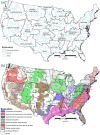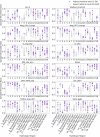Prioritizing water availability study settings to address geogenic contaminants and related societal factors
- PMID: 38400911
- PMCID: PMC10894127
- DOI: 10.1007/s10661-024-12362-2
Prioritizing water availability study settings to address geogenic contaminants and related societal factors
Abstract
Water availability for human and ecological uses depends on both water quantity and water quality. The U.S. Geological Survey (USGS) is developing strategies for prioritizing regional-scale and watershed basin-scale studies of water availability across the nation. Previous USGS ranking processes for basin-scale studies incorporated primarily water quantity factors but are now considering additional water quality factors. This study presents a ranking based on the potential impacts of geogenic constituents on water quality and consideration of societal factors related to water quality. High-concentration geogenic constituents, including trace elements and radionuclides, are among the most prevalent contaminants limiting water availability in the USA and globally. Geogenic constituents commonly occur in groundwater because of subsurface water-rock interactions, and their distributions are controlled by complex geochemical processes. Geogenic constituent mobility can also be affected by human activities (e.g., mining, energy production, irrigation, and pumping). Societal factors and relations to drinking water sources and water quality information are often overlooked when evaluating research priorities. Sociodemographic characteristics, data gaps resulting from historical data-collection disparities, and infrastructure condition/age are examples of factors to consider regarding environmental justice. This paper presents approaches for ranking and prioritizing potential basin-scale study areas across the contiguous USA by considering a suite of conventional physical and geochemical variables related to geogenic constituents, with and without considering variables related to societal factors. Simultaneous consideration of societal and conventional factors could provide decision makers with more diverse, interdisciplinary tools to increase equity and reduce bias in prioritizing focused research areas and future water availability studies.
Keywords: Arsenic; Environmental justice; Federal research; Geogenic contaminants; Groundwater; Hydrology.
© 2024. This is a U.S. Government work and not under copyright protection in the US; foreign copyright protection may apply.
Conflict of interest statement
The authors declare no competing interests.
Figures






Similar articles
-
Drinking water quality in the glacial aquifer system, northern USA.Sci Total Environ. 2019 Dec 1;694:133735. doi: 10.1016/j.scitotenv.2019.133735. Epub 2019 Aug 2. Sci Total Environ. 2019. PMID: 31401509
-
Geogenic contaminants and groundwater quality around Lake Victoria goldfields in northwestern Tanzania.Chemosphere. 2022 Nov;307(Pt 2):135732. doi: 10.1016/j.chemosphere.2022.135732. Epub 2022 Jul 21. Chemosphere. 2022. PMID: 35872057
-
Mobilization of Arsenic and Other Naturally Occurring Contaminants during Managed Aquifer Recharge: A Critical Review.Environ Sci Technol. 2021 Feb 16;55(4):2208-2223. doi: 10.1021/acs.est.0c07492. Epub 2021 Jan 27. Environ Sci Technol. 2021. PMID: 33503373 Review.
-
Uranium in groundwater--Fertilizers versus geogenic sources.Sci Total Environ. 2015 Dec 1;536:981-995. doi: 10.1016/j.scitotenv.2015.05.133. Epub 2015 Jul 11. Sci Total Environ. 2015. PMID: 26170113
-
Sources, pathways, and relative risks of contaminants in surface water and groundwater: a perspective prepared for the Walkerton inquiry.J Toxicol Environ Health A. 2002 Jan 11;65(1):1-142. doi: 10.1080/152873902753338572. J Toxicol Environ Health A. 2002. PMID: 11809004 Review.
Cited by
-
Prioritizing US Geological Survey science on salinization and salinity in candidate and selected priority river basins.Environ Monit Assess. 2024 Dec 16;197(1):59. doi: 10.1007/s10661-024-13264-z. Environ Monit Assess. 2024. PMID: 39680164 Free PMC article.
References
-
- Abbott, B. W., Bishop, K., Zarnetske, J. P., Minaudo, C., Chapin, F. S., Krause, S., Hannah, D. M., Conner, L., Ellison, D., Godsey, S. E., Plont, S., Marçais, J., Kolbe, T., Huebner, A., Frei, R. J., Hampton, T., Gu, S., Buhman, M., Sara Sayedi, S., ..., Pinay, G. (2019). Human domination of the global water cycle absent from depictions and perceptions. Nature Geoscience, 12(7), 533–540. 10.1038/s41561-019-0374-y
-
- Agathokleous, E., Barceló, D., Aschner, M., Azevedo, R. A., Bhattacharya, P., Costantini, D., Cutler, G. C., De Marco, A., Docea, A. O., Dórea, J. G., Duke, S. O., Efferth, T., Fatta-Kassinos, D., Fotopoulos, V., Ginebreda, A., Guedes, R. N. C., Hayes, A. W., Iavicoli, I., Kalantzi, O.-I., ..., Calabrese, E. J. (2022). Rethinking subthreshold effects in regulatory chemical risk assessments. Environmental Science & Technology, 56(16), 11095–11099. 10.1021/acs.est.2c02896 - PubMed
-
- Agency for Toxic Substances and Disease Registry. (1999). Toxicological profile for ionizing radiation. Atlanta, Georgia Retrieved from https://www.atsdr.cdc.gov/ToxProfiles/tp149.pdf - PubMed
-
- Aizebeokhai AP, Oyeyemi KD, Adeniran A. An overview of the potential impacts of climate change on groundwater resources. Journal of Informatics and Mathematical Sciences. 2017;9(2):437–453.
-
- Allaire M, Acquah S. Disparities in drinking water compliance: Implications for incorporating equity into regulatory practices. AWWA Water Science. 2022;4(2):e1274. doi: 10.1002/aws2.1274. - DOI
MeSH terms
Substances
LinkOut - more resources
Full Text Sources

